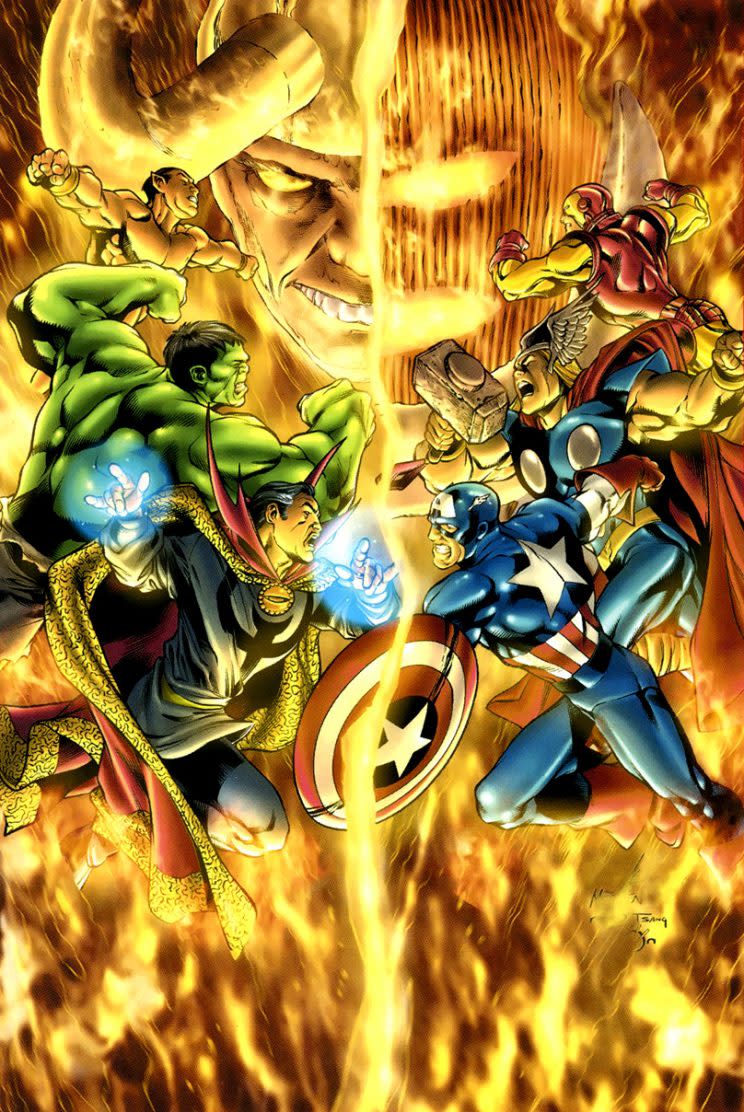What 'Doctor Strange' Means to the Future of the Marvel Cinematic Universe (Spoilers!)

Warning: This story discusses major plot points of Doctor Strange. Please see the film first if you want to avoid spoilers.
Doctor Strange is the 14th film in the Marvel Cinematic Universe. It’s also the second, after Captain America: Civil War, in the studio’s Phase Three — a wave which will culminate in 2019 with a (final?) Avengers team up. Although arriving late in the game, Doctor Strange represents a key touchstone in the comic-based continuity, not only referencing past films, but also charting a path into a future that could affect superheroes for years to come. Let’s take a look how Doctor Strange fits in the MCU and what it could portend.
The film establishes its Marvel bona fides early and often. There in the Manhattan skyline is Avengers Tower, rebuilt after that nasty business with Ultron.

Later, during Stephen Strange (Benedict Cumberbatch)’s ill-fated joy ride, we get another tossed-off line that seems Easter eggy. He fields a call from his office suggesting potential patients; one is described thusly: “I’ve got a 35-year-old Air Force colonel, crushed his lower spine in some kind of experimental armor…”
Because Doctor Strange is set near the events of Civil War, you might think the injured party is Don Cheadle’s Rhodey Rhodes/War Machine. Or perhaps it’s a deeper-cut nod to 2010’s Iron Man 2 and one of the unfortunate military test subjects forced to wear the faulty Hammer Tech suits.

However, Strange director Scott Derrickson has gone on record saying neither is true, so it could be a case of us looking for Marvel clues that aren’t there, or it could refer to someone we haven’t met yet, since the Marvel U is lousy with guys in experimental suits. Which brings us to another would-be patient with an intriguing condition: “How about a 22-year-old female with an electronic implant in her brain to control schizophrenia, struck by lightning…”
Could this be Carol Danvers, a.k.a. Captain Marvel, who’s going to be played by Brie Larson in a 2019 movie? The origin story doesn’t come close to matching up with the comics, but the MCU has altered those before. Perhaps another character? Perhaps a red herring? Anyhow, it’s something to keep in mind as we continue through Phase Three.
There are other, more definite MCU references. Some are fun, yet inconsequential: Take Stan Lee’s cameo as a bus rider who declares the book he’s reading, Aldous Huxley’s The Doors of Perception, “hilarious!” as Doctor Strange astral projects nearby. Others, however, are significant. Strange’s time-shifting Eye of Agamotto is revealed to be an Infinity Stone, presumably the Time Stone, and therefore a target of the approaching Thanos. Five of the stones have been revealed now, and if Thanos is able to affix all six to his Infinity Gauntlet, he will have ultimate power — and require the combined efforts of the MCU heroes, Strange included, to be defeated. That’s the set up for 2018’s Avengers: Infinity War.

The mid-credits sequence, meanwhile, in which Strange has a sitdown with Thor (Chris Hemsworth), sets up 2017’s Thor: Ragnarok. Thor has apparently discovered that Loki, in the guise of Odin, has captured the throne of Asgard. The real Odin has been cast away, wandering the streets of New York in an amnesiac haze. Thor seeks the help of Strange to find his father, a quest that will take up a portion of the events in Ragnarok. (Fun fact: This scene was shot by Ragnarok director Taika Waititi. It was one of two Strange sequences helmed by a different MCU filmmaker: the Stan Lee cameo was directed by Guardians of the Galaxy‘s James Gunn.)
The post-credits stinger, on the other hand, provides fodder for a Doctor Strange sequel. It revealed that Mordo (Chiwetel Ejiofor) has become jaded with the teachings of the Ancient One and has set out to steal magic from others because he feels “there are too many sorcerers.” In the comics, Mordo and Strange are archenemies, so it’s only natural that the inevitable Doctor Strange follow-up would explore their fractious relationship. (For more on the two credits sequences, read our in-depth analysis.)
The most tantalizing foreshadowing, however, comes via a bit of exposition provided by Wong (Benedict Wong), the guardian of the Ancient One’s library and an ally of Strange’s. As seen in the clip below, he informs the doctor, “Heroes like the Avengers protect the world from physical dangers. We safeguard it against more mystical threats.”
But what if the Earth was confronted by a threat both mystical and physical? In a classic Marvel Comics crossover, Doctor Strange and his own elite team called the Defenders (which featured a different lineup than the MCU team of Daredevil, Luke Cage, Iron Fist, and Jessica Jones assembling on Netflix) must join forces with the Avengers to stop the combined attack of Loki and Dormammu. The Defender-Avengers War might have too much overlap with Civil War, but the storyline could easily be adapted to fit the MCU.

After all, Dormammu is a hugely powerful entity and almost too easily thwarted at the end of Doctor Strange. Surely he’d want another crack at Earth, and by teaming with perpetual loser Loki, the Dark Dimension dweller would have a formidable partner requiring heroes aplenty to defeat the diabolical duo. (Over the years Dormammu has also tangled with the Guardians of the Galaxy and New Avengers in the comics.)
We’re not certain what enemies the Avengers will face post-Infinity War, but with Doctor Strange expanding the MCU into other dimensions, there’s a whole multiverse of baddies out there — enough for Phase Four and beyond.
Watch Cumberbatch talk about the magic in ‘Doctor Strange’:

